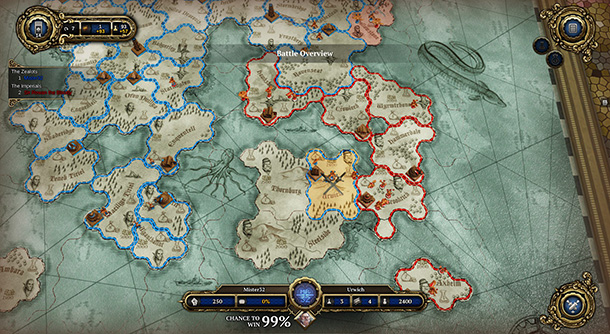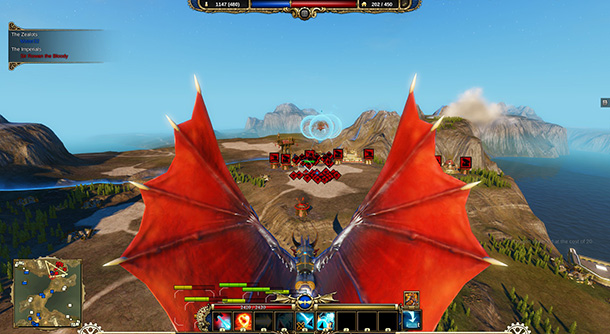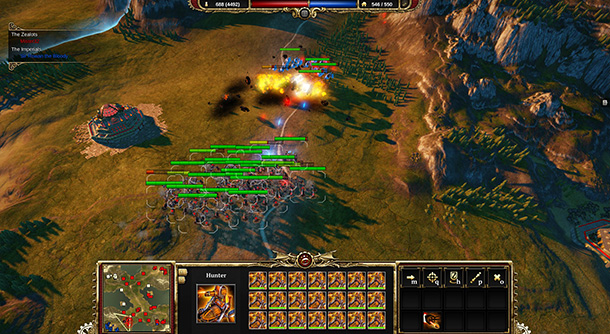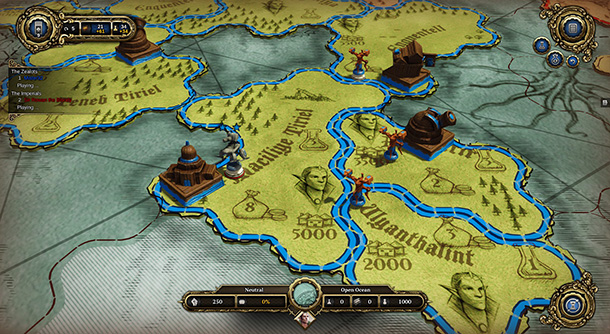When the opportunity to play and review Divinity: Dragon Commander came to me, I was told that “it has dragons with jetpacks,” and I was sold. Doing some initial research it seemed to be in the vein of the RTS games that I played long ago — games such as Red Alert, Warcraft and Age of Empires — which made me realize it had been over a decade since I played a deep PC RTS game. After recovering from that shock, I dove in with what would more or less be a fresh perspective of the genre.

At the time of review, access to the single player in our beta build was initially iffy. We’ve been able to pick it up since then, but the meat of the game really is in the multiplayer. I joined a random lobby and set myself to “ready”, bracing for a beating. When the game started up I was greeted by a large detailed map reminiscent of Risk, complete with deep sea beasts etched in ink out in the waters and penciled in cogs turning at the country edges.
From here the gameplay consisted of moving my pieces to capture territories, developing my land with buildings, researching new units and abilities for both my army and dragon form [which I’ll get to later] and playing cards with a variety of effects on the country and units. Piece movement and land development was pretty straight forward, and despite going in with no clue what I was doing, I picked up on what everything did and how certain buildings work within an hour of play. I think one of the nicest small bits of this game is that practically everything has a tool-tip. Unit production even provided short animated clips showcasing how each one fared out in the field, giving a very visual sense of, “Don’t let that soldier fight that other guy or you’re going to die” or “this skill will totally destroy that obstacle” effectively communicating strengths and weaknesses. For someone who had never played the game, it is extremely helpful.
Once I started to spread out a bit, it was only a matter of time before I began encroaching on the territory of my foe. When we finally crossed blades it was similar at first to Advanced Wars for the Game Boy Advance. It gave me a simple stack up of units present in the territory going into battle as well as a chance percentage of my victory if I just let the AI take care of it. When I let the AI go at it, it runs the simulation based on my chance to win, and that’s it. The whole ordeal is over in seconds. However, if the percentage was low I could opt to take things into my own hands and try to overcome the odds. Which takes me into…
The RTS portion of the game! In multiplayer, maps are symmetric with clear bases for up to four players in the ones I found myself in. I begin in your corner with whatever units I brought into battle from the previous “Risk” portion of the game. In one battle was particularly memorable I advanced on the enemy’s capital and surprisingly found myself overwhelmed with only a 30% chance to win, so of course I opted to fight the good fight and see how bad it really was. Taking a gander at the enemy base revealed that they started out with almost 20-30 units immediately. I was understandably intimidated, but pressed on nonetheless. Remember earlier when I mentioned how units had strength and weaknesses, almost rock-paper-scissors style? My foe may have had a formidable army, but it consisted of nothing but light troopers and I was able to tear them apart by choosing the right units to counter with.
That was even before I morphed into a jetpack-mounted dragon of death and destruction.

One of the very unique pieces that sets Dragon Commander apart from other RTS games is the ability to turn into a dragon. After a preset amount of time I — rather, my cursor — am given the chance to change into a flying, fire breathing scaly reptile of horror, essentially taking control of one of my flying units. I can directly attack enemy units and buildings, as well as buff my own army or hinder my foe. I can scream across the sky aided by my jetpacks to get right into the thick of battle, and even use those jetpacks to dodge incoming enemy attacks. And yet, it was still relatively easy to control my collective army in the same vicinity. Throughout the territory-capture portion of the game I can also spend research into learning new abilities, both passive and active, for my dragon. Even when I was losing other games, it felt awesome to just control the dragon in battle.
The single player campaign takes the mechanics of the multiplayer version and weaves in plot elements — marrying a princess, choosing sides between warring countries, for instance — through a narrative that is created as one continues along capturing territories. Without having much of a chance to take the single player campaign out for a spin, Divinity: Dragon Commander sits soundly on its multiplayer capabilities. In fact, my multiplayer time was totally worth the price of admission alone.
If you can get behind a good strategy game, I suggest you get behind this one. It offers a lot before you even need to touch the single player narrative campaign. Dragon Commander could shape up to be a fantastic game worthy of hours of your time.

This review is based on pre-release code sent to SideQuesting by the publisher. There were initially some issues with accessing the single player mode, as it was based off of the Beta code. The retail version does not have this issue.


No Comments